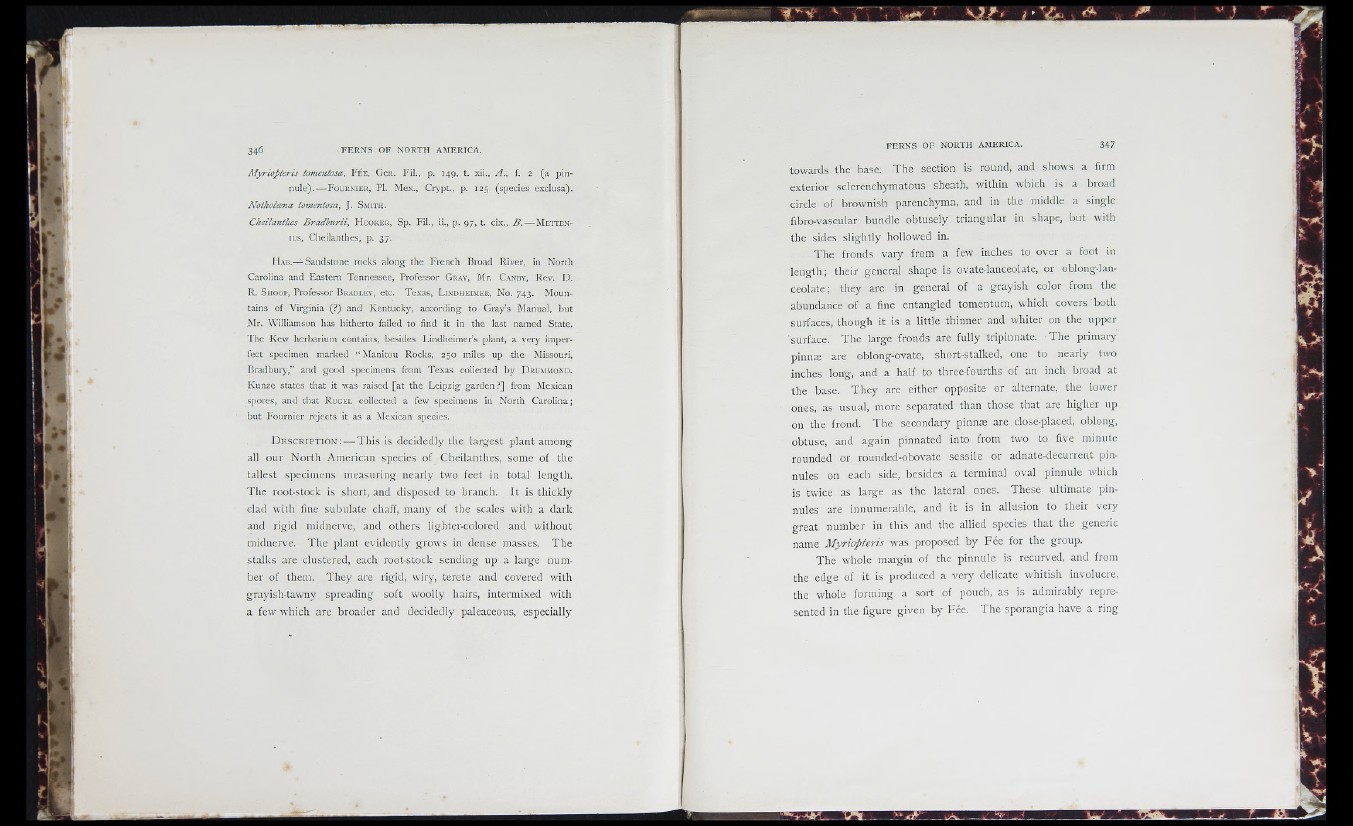
f *
r
k I
ï t
Myriopteris tomentosa. F é e , Gen. Fil., p. 149, t. xü., A ., f. 2 (a pinnule).—
F o u r n i e r , Pl. Mex., Crypt., p. 125 (species exclusa).
Notholæna tomentosa, J. Sm ith .
Cheilanthes Bradburii, H o o k e r , Sp. Fil., ii., p. 97, t. cix., B . — M e t t e n iu
s , Cheilanthes, p . 37.
H a b .^ Sandstone rocks along the French Broad River, in North
Carolina and Eastern Tennessee, Professor G r a y , Mr. C a n b y , Rev. D.
R. S hoop, Professor B puvdlev, etc. Texas, L in d h e im e r , No. 743. Mountains
of Virginia (?) and Kentucky, according to Gray’s Manual, but
Mr. Williamson has hitherto failed to find it in the last named State.
The Kcw herbarium contains, besides Lindheimer’s plant, a yery imperfect
specimen marked “ Manitou Rocks, 250 miles up the Missouri,
Bradbury,” and good specimens from Texas collected by D rum m o n d .
Kunze states that it was raised [at the Leipzig garden?] from Mexican
spores, and that R u g e l collected a few specimens in North Carolina;
but Fournier rejects it as a Mexican species.
D e s c r i p t i o n : — This is decidedly the largest plant among
all our North American species of Cheilanthes, some of the
tallest specimens measuring nearly two feet in total length.
The root-stock is short, and disposed to branch. It is thickly
clad with fine subulate chaff, many of the scales with a dark
and rigid midnerve, and others lighter-colored and without
midnerve. The plant evidently grows in dense masses. The
stalks are clustered, each root-stock sending up a large number
of them. They are rigid, wiry, terete and covered with
grayish-tawny spreading soft woolly hairs, intermixed with
a few which are broader and decidedly paleaceous, especially
towards the base. The section is round, and shows a firm
exterior sclerenchymatous sheath, within which is a broad
circle of brownish parenchyma, and in the middle a single
fibro-vascular bundle obtusely triangular in shape, but with
the sides slightly hollowed in.
The fronds vary from a few inches to over a foot in
length; their general shape is ovate-lanceolate, or oblong-lanceolate;
they are in general of a grayish color from the
abundance of a fine entangled tomentum, which covers both
surfaces, though it is a little thinner and whiter on the upper
surface. The large fronds are fully tripinnate. The primary
pinnæ are oblong-ovate, short-stalked, one to nearly two
inches long, and a half to three-fourths of an inch broad at
the base. They are either opposite or alternate, the lower
ones, as usual, more separated than those that arc higher up
on the frond. The secondary pinnæ are close-placed, oblong,
obtuse, and again pinnated into from two to five minute
rounded or rounded-obovate sessile or adnate-decurrent pinnules
on each side, besides a terminal oval pinnule which
is twice as large as the lateral ones. These ultimate pinnules
are innumerable, and it is in allusion to their very
great number in this and the allied species that the generic
name Myriopteris was proposed by Fée for the group.
The whole margin of the pinnule is recurved, and from
the edge of it is produced a very delicate whitish involucre,
the whole forming a sort of pouch, as is admirably represented
in the figure given by Fée. The sporangia have a ring